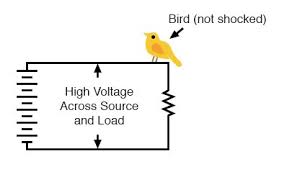Do you sometimes wonder why birds and some other animals like squirrels, sit and play over high voltage transmission lines without getting electrocuted? Our curiosity can go as far as making us assume that birds and squirrels feets are covered by strong insulators, or their body are resistance to electricity. The fact is that none of these assumptions are basically true because the reason why this happens is not owing to any special abilities. Birds or squirrels are absolutely not immune to electric shock( as you see in the image below). Here is what really happens.
What is electric shock or electrocution: Electric shock is the sudden discharge of electric current into the body which can cause severe injury or a permanent damage to the body. Electrocution is when the victim dies from it at that point. For us to know why current isn't flowing through birds or squirrels sitting on a high voltage wires, we first have to know the three things needed for electric current to flow in the first place.
What is needed for current to flow
- A voltage source: Voltage is what provides the electromotive force for electrons to flow round a circuit. Just like a water pump is needed to provide the pressure needed to pump water through a pipe, so in the case of electricity, voltage is what provides the drive force for electric current and it always relative between two point. You'll never see a battery or an AC generator having just one terminal, it should have two active wires or terminals.
- A closed circuit: For electrons to flow continuously, they must be a path, and that path is called a circuit. But electrons doesn't have infinite sources and destinations so a closed circuits provides a complete path for electrons to flow round a conductor. It doesn't matter the type of current, whether it an alternating current(AC) or a direct current(DC) they all require a closed circuit.
- A path of NO or relatively LOW resistance: There is practically no conductor with zero resistance, but for electric current to flow the resistance on a circuit must not be high enough to completely stop the flow of current in that circuit. Electric current highly prefer the path of lower resistance, that means a very least amount of current will flow in a in a path filled with electrical resistance.
Each of these 3 criteria plays a role on why birds and squirrels do not get electrocuted when playing on what suppose to roast them to ashes. Let explore.
POINT 1: ONE POINT CONTACT - As we’ve already learned, electricity requires a complete path (closed circuit) to continuously flow. Without two contact points on the body for electric current to enter and exit respectively, there is no hazard of shock. This is why birds and squirrels can safely rest on high-voltage power lines without getting shocked because they make contact with the circuit at only one point. When current is generated from the source (power plants) to the transmission lines, it follows a loop pattern. From the live wires to different loads (transformers, home appliances) and then the earth wire(or ground) acts as the return path for this current to flow back to the source . Birds or squirrels do not take part in this loop because they always land on either of these wires.
POINT 2: In order for electrons to flow through a conductor, there must be a voltage present to motivate them. Voltage, as you should recall, is always relative between two points. There is no such thing as voltage ”on” or ”at” a single point in the circuit, and so the bird contacting a single point in the above circuit has no voltage applied across its body to establish a current through it. Yes, even though they rest on two feet, both feet are touching the same wire, making them electrically common. Electrically speaking, both of the bird’s feet touch the same point, hence there is no voltage between them to motivate current through the bird’s body.
For schematic view of both scenario, see this diagram:
POINT 3: Birds, squirrels and even some other animals have a rather higher resistance to electricity. As earlier mentioned, electric current flow chooses the path of lower resistance. Birds do not offer an easy path for current to flow due to it high electrical resistance, so current bypasses the birds and chooses the path of lower resistance which are the copper or aluminium cables.
























0 comments:
Post a Comment